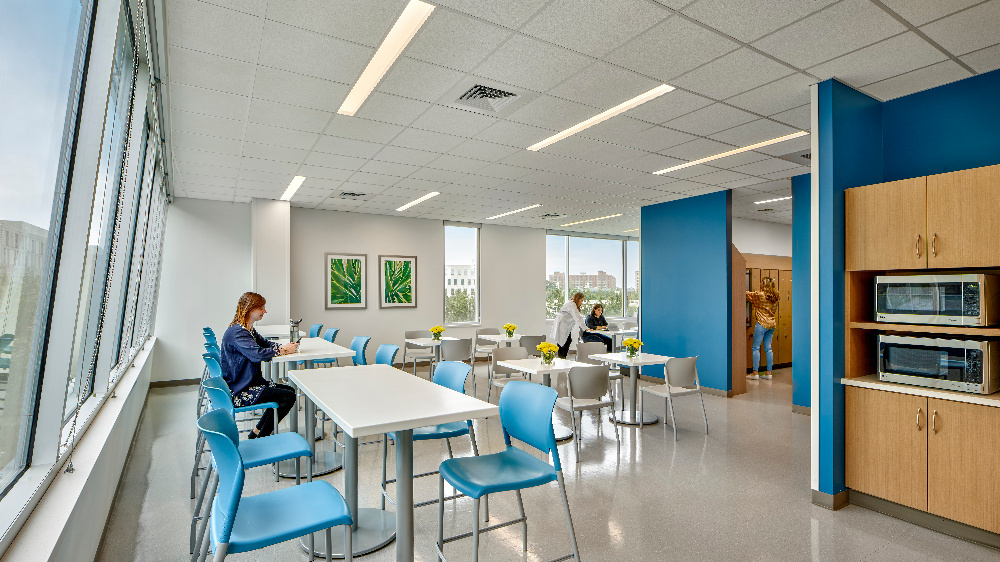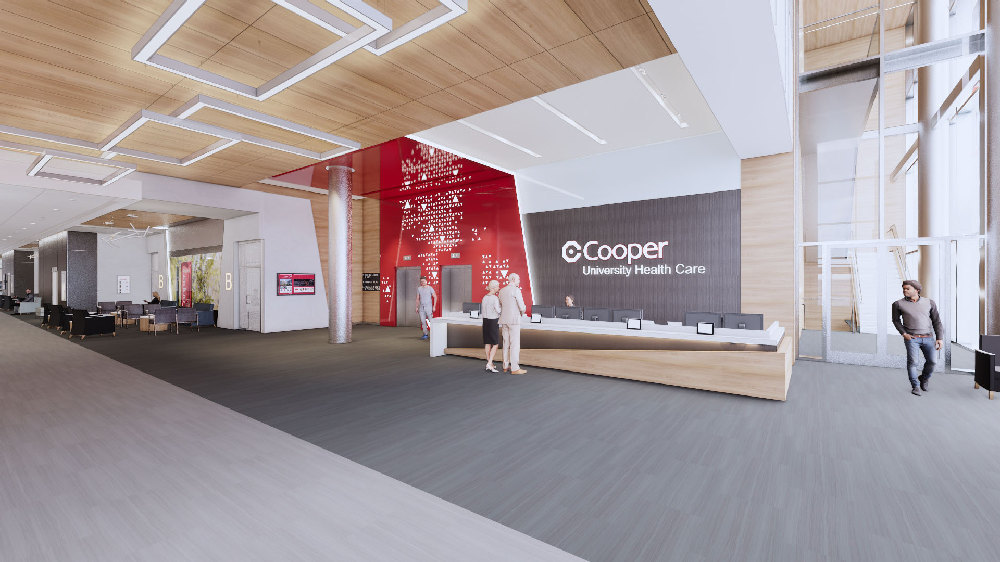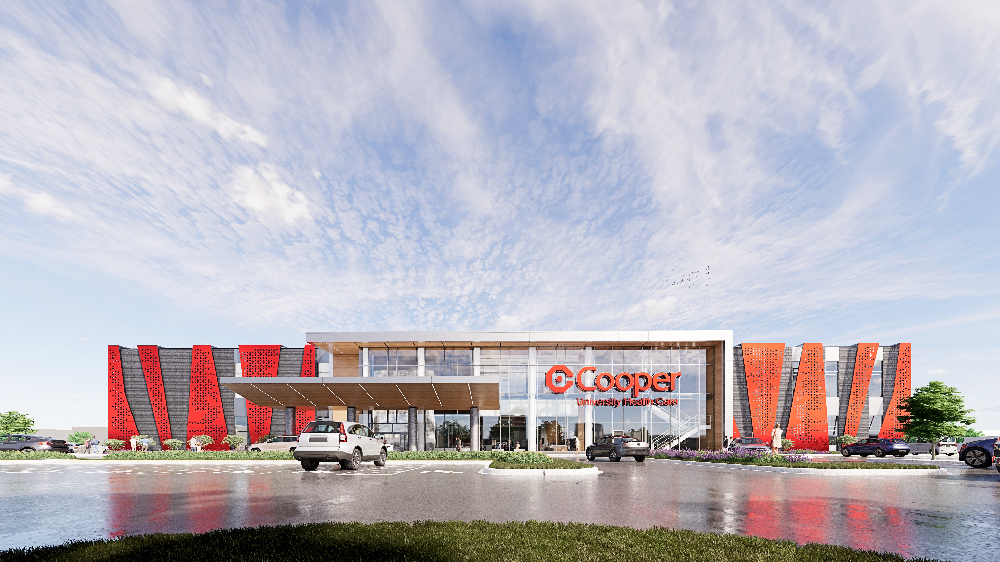 Thomas Jefferson University's outpatient center at the Philadelphia Navy Yard includes communal lockers and lounge areas for staff on the second floor, shared team center and collocated offices on the fourth floor.
Thomas Jefferson University's outpatient center at the Philadelphia Navy Yard includes communal lockers and lounge areas for staff on the second floor, shared team center and collocated offices on the fourth floor.  Access and wayfinding set the stage for physician, staff and patient satisfaction.
Access and wayfinding set the stage for physician, staff and patient satisfaction.  Under construction, Cooper University Health Care’s ambulatory care facility in Moorestown, New Jersey is located at the site of a converted Sears and provides convenient access to the community.
Under construction, Cooper University Health Care’s ambulatory care facility in Moorestown, New Jersey is located at the site of a converted Sears and provides convenient access to the community.  Under construction, Cooper University Health Care’s ambulatory care facility in Moorestown, New Jersey is located at the site of a converted Sears and provides convenient access to the community.
Under construction, Cooper University Health Care’s ambulatory care facility in Moorestown, New Jersey is located at the site of a converted Sears and provides convenient access to the community. Subscribe Now
5 Considerations for Facility Planning Amidst Unprecedented Change
By Michael Rovinsky
Although the pace of change may vary considerably by market, based solely on the continuing escalation of the cost of healthcare, significant change in healthcare is necessary and inevitable. Fortunately, we can predict a lot about what the future healthcare environment will look like and require. The following five considerations and their implications for facility planning are most pressing.
1) Declining reimbursements further erode hospital margins
Cost escalation in healthcare is unsustainable, and the anticipated insolvency of the Medicare Hospital Insurance Trust Fund in 2029 is proof thereof. So what can clients do to position themselves for success in such an environment? There are only two levers to pull: increase revenue and/or decrease expenses.
While mechanisms for increasing revenue have clear strategic implications, the need to decrease expenses has more direct implications for facility planning. In fact, the long-term savings achieved through operational efficiency dwarf the first-dollar cost of new construction. Increasing operational efficiency is a direct result of facility planning that incorporates operational and clinical expertise in the design of new or renovated space. However, process change management is a critical component of facility planning if the potential savings are to be realized.
2) Age of consumerism impacts where patients get care
From a facility planning perspective, there are a variety of things that help improve the patient experience. First, only the most complex care that needs to be performed at the hospital should be provided at the hospital. The rest should be geographically distributed as close to where patients work and live as appropriate.
This strategy is complicated by the desire to retain provider-based payment for as many services as possible for as long as it is available. However, that desire should be tempered by the knowledge that consumers are increasingly choosing to receive care at more convenient, less-costly alternative sites. In addition, based on a recommendation from the Medicare Payment Advisory Commission, there is an increasing push toward site-neutral payment for lower-acuity services. Regardless of the outcome of that debate, the financial benefits of providing lower-acuity care, including ambulatory surgery at or near the hospital will diminish or be eliminated over time.
3) If we don’t get it right, someone else will
Hospitals and health systems cannot wait for their market to be disrupted to react. Once patient loyalty and market share are lost, regaining them will be extremely difficult. As challenging as it may be to convince a CFO to open freestanding imaging centers when the healthcare system can still get provider-based payment rates, clients should at least position to throw the switch overnight.
One way to expedite this transition is to establish joint ventures with existing providers of lower-cost, more convenient care. In the short term, while provider-based payment is still available, the joint venture can focus on de novo sites to penetrate new or underserved markets, minimizing the impact on existing revenue streams. However, at some point, hospitals and health systems will need to be in the business of providing most “shoppable services” at lower cost, more convenient settings. In either case, partnering with existing providers who excel at optimizing the customer experience, can reduce the capital required from the health system to establish such sites, thereby preserving limited capital for other projects and providing often-needed operational expertise.
4) Physicians continue to drive healthcare utilization and cost
Hospitals and health systems must truly align interests with physicians, both clinically and financially. Shy of full employment, there are many models for doing so, including provider service agreements, co-management agreements, ACO participation and management services arrangements. From a facility planning standpoint, there are several additional ways to align clinical and financial interests.
Financially, physicians continue to seek alternative revenue streams to boost income in an environment of declining reimbursement. Providing opportunities for physicians to participate in owning real estate remains a viable way to align interests, while reducing capital requirements from the health system. However, convenience and operational efficiency are probably the best ways to align interests and retain loyalty.
Important facility planning-related operational efficiencies include appropriate adjacencies of related services and modalities, efficient floor plans within departments, sufficient operating room capacity to enable surgeons to flip rooms to optimize productivity, and on-unit charting areas for real-time documentation. Of course, fully integrated electronic medical records across the health system are essential for efficiency.
5) Staffing shortages are not likely to go away soon
The “great resignation” is persistent in healthcare, with pandemic-related burnout and other factors leading to early retirement and resignation in favor of safer, less stressful and more lucrative jobs. The ongoing lack of sufficient employees to staff available hospital beds has a direct implication for facility planning.
Many hospitals are contemplating or planning for the construction of new inpatient towers or floors, some with existing unused bed capacity due to lack of available staff, and others without knowing if or how they will be able to recruit sufficient staff to operate the new facilities. Solving this conundrum requires innovative approaches to staff recruitment and retention, as well as technological solutions to automate or outsource more functions. However, if a health system proceeds with facility development, designing to optimize operational efficiency and accommodate enabling technology is essential.
Efficient departmental adjacencies and floor plan layout enable existing staff to be more productive. Examples include collocating diagnostic and treatment platforms to share prep/recovery areas and staff, shared central waiting rooms for multiple services to reduce clerical staff and central transport for services that do not have a critical mass of transport needs. In addition, designing spaces to improve staff experience can help with staff retention.
Although we can anticipate a lot about the future healthcare environment, there are things we don’t and can’t know, like mass casualty events or future pandemics. To address this uncertainty, flexibility is the key for facility planning. Otherwise, we have a good sense of what the future healthcare environment will look like and require.
Accordingly, it is incumbent for healthcare systems to position themselves to succeed in that environment through careful and diligent facility planning, regardless of the expected pace of change in their unique marketplace. Identifying and bringing the right resources that integrate strategic, operational, clinical and financial expertise into facility planning and design is essential for optimizing performance in a rapidly changing environment.
Photos courtesy of Array Architects
Author: Michael Rovinsky
Michael Rovinsky is vice president, strategic planning at Array Advisors.
Tags: Array Advisors, Facility Planning, Medicare Payment Advisory Commission, Staffing shortages
Posted December 13, 2023
More Articles:
- CxA Workshop & Exam
Apr 29, 2024 – Apr 30, 2024 - EMP Seminar & Exam at CxEnergy 2024
Apr 29, 2024 – Apr 30, 2024 - CxEnergy
Apr 29, 2024 – May 2, 2024 - PHCC West 2024
Apr 29, 2024 – May 2, 2024 - Lean in Design Forum 2024
May 1, 2024 – May 2, 2024 - IFMA’s Facility Fusion Conference & Expo
May 5, 2024 – May 7, 2024 - ASHE Academy 2024
May 6, 2024 – May 10, 2024










